Norpro 2-Cup
Measuring Shaker

Flat Whisk
Use for Gravies

OXO Sauce &
Gravy Whisk

OXO
Wooden Spoons. Use
when Cooking Tomato Sauces

Cooked Sauces: With Tomatoes: Served Cold
Mom's NeanderThin Ketchup
The NeanderThin-approved version of America's favorite condiment. (Submitted by Ray's mom, who, although in her seventies, is a NeanderThin convert and is not to be trifled with!)
3 1/3 pounds tomatoes, sliced
2 medium sliced onions
1/8 clove garlic
Approximately 1/2 bay leaf (small)
1/2 red pepper
1/4 cup unsweetened juice (select naturally sweeter ones: white grape, pear, or apple)
1 spice bag (see Notes)
1/2 cup freshly squeezed lemon juice
Cayenne and coarse salt (optional)
1. Boil tomatoes, onions, garlic, bay leaf, and red pepper until they are soft, about 20-30 minutes. Strain them.
2. Add juice to strained ingredients.
3. Add spice bag to mixture, boiling ingredients quickly, stirring frequently until they are reduced to half the quantity. Remove spice bag.
4. Add lemon juice, cayenne, and salt.
5. Boil ketchup for 10 more minutes. Bottle (see Notes) at once in clean jars leaving 1/4 to 3/4 inch of headroom (for freezer swell). Cover and freeze immediately. Always refrigerate container of ketchup that is in use.
NOTES: The spices can be varied. Try 1 teaspoon of each of the following: allspice, black peppercorns, celery seeds, cloves, and mace, plus 1/2-inch cinnamon stick. Tie the spices in cheesecloth.
Choose containers (plastic or glass) of a size that your family will use in a week's time. Since there are no preservatives added, the ketchup will spoil once it is defrosted.
From:
NeanderThin: Eat Like a Caveman to Achieve a Lean, Strong, Healthy Body by Ray Audette
Included here with the author's permission.
To Print or Pin the Recipe, or to Post and/or Read
Comments

Cocktail Sauce
1 cup ketchup
2 Tbsp. prepared horseradish
2 Tbsp. lemon juice
Mix the ingredients together, and taste.
If desired, add mayonnaise, hot sauce or worcestershire sauce (Try 1/2 tsp. at a time). Chill before serving.
From:
The Balance Everyday
To Print or Pin the Recipe, or to Post and/or Read
Comments
Basic Cocktail Sauce Recipe
6 tablespoons tomato ketchup
2 tablespoons horseradish
4 tablespoons lemon juice
celery salt to taste
Tabasco sauce
Shake all ingredients until well mixed. Add celery salt and tabasco sauce to your taste. Chill and serve.
From:
CDKitchen
To Print or Pin the Recipe, or to Post and/or Read
Comments
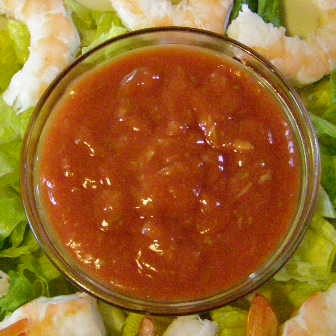 CDKitchen: hazelhammond
CDKitchen: hazelhammond
Classic Shrimp Cocktail Sauce
1 cup of tomato ketchup
1/2 teaspoon light chili powder
1 dash of ground cayenne pepper
1 teaspoon of prepared horseradish
2 teaspoons of fresh squeezed lemon juice
1 large minced garlic clove
In a small mixing bowl add in the ketchup, light chili powder, cayenne pepper, prepared horseradish, fresh squeezed lemon juice, and the minced garlic clove. With a large wooden spoon vigorously mix these ingredients together until your sauce is even and consistent. Transfer the mixing bowl contents into a small dipping bowl. You may serve immediately, or let it chill in the refrigerator for an hour. Note that the chilling process will work to blend and sharpen the flavors, and in some cases make your sauce taste a little spicier.
From:
ShrimpCocktailSauce.com [archive.org]
To Print or Pin the Recipe, or to Post and/or Read
Comments
Cooked Sauces: With Tomatoes: Served Hot
NeanderThin Barbecue Sauce
The crown jewel of the NeanderThin kitchen.
2 cloves garlic, minced
2 tablespoons finely chopped onion
2 tablespoons bacon fat
1 teaspoon chili powder, or more to taste
1 teaspoon dried rosemary leaves, crushed
1/2 teaspoon coriander seeds, finely ground or crushed
1 teaspoon ground ginger
One 6-ounce can tomato paste
1/2 cup water, or more if needed
6 ounces 100% natural apple juice concentrate
Juice of 1 orange (1/3 to 1/2 cup, more or less)
1. Sauté garlic and onion in bacon fat over medium-low heat until tender, 5 to 10 minutes.
2. Add chili powder, rosemary, coriander, and ginger.
3. Add all other ingredients and stir until well blended.
4. Cover and simmer over low heat for at least 30 minutes to let flavors blend. If sauce becomes too thick, add more water.
From:
NeanderThin: Eat Like a Caveman to Achieve a Lean, Strong, Healthy Body by Ray Audette
Included here with the author's permission.
To Print or Pin the Recipe, or to Post and/or Read
Comments

Homemade Tomato Sauce
2 (28 ounce) can diced or whole tomatoes
1 medium yellow onion, finely chopped
2 celery stalks, finely chopped
3 tablespoons olive oil
5 to 6 large garlic cloves, minced
1 teaspoon dried oregano
1 teaspoon dried basil
1 teaspoon salt
1/2 teaspoon fresh ground pepper
Use either an immersion blender or drink blender to purée tomatoes, set aside.
In a medium saucepan over medium heat, cook onion and celery in oil until soften. Add in garlic and spices; cook 1 minute; stir occasionally. Stir in puréed tomatoes. Cover with lid, allow for stream to escape. Bring to a boil, reduce heat to a simmer and cook for 30 minutes. Stirring occasionally.
Now at this point, you will have a slightly chunky tomato sauce.
However, if you prefer a smooth sauce, you'll want to use the immersion blender, again, to purée the sauce. You can also use a drink blender to do the same job. Just be careful handling while handling the hot tomato sauce. Hold down the top to the drink blender when you turn it on. The heat from the sauce will make it POP off and you'll have hot food on you and all over the counter.
After the sauce is puréed, carefully pass it through a sieve that is set over a medium bowl. Use a rubber spatula to press the sauce through the sieve. Be sure to scrape the bottom of the sieve, too. Don't waste any of the sauce. It all goes into the bowl. Discard any vegetable and spice bits. This is a very important step that gives you a deliciously smooth sauce.
If you have kids or adults that don't like chunky pasta sauces, but you like sauces with a lot of flavor, this is your happy place. Leftover tomato sauce freezes very well and can easily be reheated in the microwave without losing any of its great flavor.
From:
Simple Daily Recipes
To Print or Pin the Recipe, or to Post and/or Read
Comments
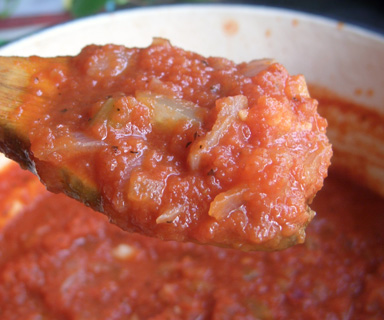 Jill McKeever
Jill McKeever
Pizzaiola Sauce
1 1/2 to 2 pounds ripe tomatoes, peeled, seeded and chopped
1/4 cup olive oil
2 garlic cloves, minced
pepper, to taste
1 tsp dried oregano
1/4 cup minced parsley
Heat oil in a heavy pan. Add all the other ingredients. Cook over high heat, stirring all the time, for about 5 to 7 minutes, or until the tomatoes are just soft and hot. Serve with steaks.
From:
Nika Hazelton's Way with Vegetables
To Print or Pin the Recipe, or to Post and/or Read
Comments

Basque Tomato Sauce
1/4 cup olive oil
8 cloves garlic, peeled and crushed
2 cups peeled and diced yellow onions
1 1/2 cups cored, seeded and diced green bell peppers
3 cups very ripe tomatoes, diced
1 4 oz can whole green chiles, Mexican style, puréed
1/4 cup chopped parsley
5 cups beef stock
pepper to taste
In a 6 quart saucepan sauté the garlic, onion and green pepper in the oil until tender. Add the tomatoes, puréed chiles, and parsley and simmer until very tender. Add Beef Stock. Cover and simmer 1 hour. Uncover and simmer 1 hour more to reduce and thicken the sauce. Stir occasionally, pepper to taste.
From:
The Frugal Gourmet by Jeff Smith
To Print or Pin the Recipe, or to Post and/or Read
Comments

Sofrito
The seasoning combination sofrito is found in many cultures. Add it to your favorite soup or sauce to add extra flavor. It is also great when tossed with steamed shellfish. When using this recipe, I will use 1 tablespoon at a time, keeps in fridge up to 2 weeks. Makes about 1 cup
1/4 cup Celery, diced
1/4 cup Onion, diced
1/4 cup Green bell pepper, diced
1/4 cup Tomatoes, diced
2 cloves Garlic, minced
1 1/2 Tablespoons Fresh herbs (cilantro or basil work well)
1 1/2 Tablespoons Olive oil
Place all ingredients (except the oil) and pulse until a course sauce forms (similar to salsa). Heat the oil in a heavy skillet over medium heat. Saute the sauce for 5 minutes.
By Trish Tipton. Posted to the PaleoRecipe Mailing List, Feb. 2001
To Print or Pin the Recipe, or to Post and/or Read
Comments
Cooked Sauces: Without Tomatoes
Jerk Sauce
2 ounces whole Jamaican Allspice, crushed
1/4 tsp freshly grated nutmeg
1 tsp ground cinnamon
12 scallions, cleaned and chopped
6 Habenero peppers or 12 Jalapenos, halved _with_ the seeds
1/3 cup lime juice
4 TBL olive oil
1 tsp salt
1 tsp freshly ground black pepper (or more)
some rum to taste
Crush the allspice in a mortar and pestle or a coffee grinder or pepper grinder. Leave it fairly coarse in good sized chunks. Combine all the ingredients in a blender or food processor. Process until liquified and well blended. Pour it in a jar (glass only--it eats plastic) and refrigerate until you are ready to use it.
Notes from the friend who gave me the recipe:
This makes about a cup and it's pretty thick. I leave it like that and then add more oil to marinate the meat when I'm ready. Roughly 2 good, rounded teaspoons of this, blended with oil to thin it out, will suffice to marinate 2 full chicken breasts (4 pieces) to a very hot level. It doesn't need to marinate all that long either, half hour to an hour is plenty, so it makes an easy quick dinner. It goes a long way and keeps very well in the refrigerator. If you don't want to make this much, it's easy to just cut the recipe in half or so.
Adapted from
Island Cooking: Recipes from the Caribbean by Dunstan A. Harris
To Print or Pin the Recipe, or to Post and/or Read
Comments

Deep Fry Batter
1 can coconut milk
2 eggs
2-3 T arrowroot
Application of coconut oil is for deep-frying banana fritters, where the batter is made from a can of coconut milk, two free range eggs and two or three tablespoons of arrowroot flour.
(here's mine) Dip meat, veggies (or I suppose fruit) in egg. Then coat in arrowroot and fry in olive oil.
From: Richard Archer
To Print or Pin the Recipe, or to Post and/or Read
Comments

Mojo de Ajo
Guajillo [gwah-HEE-yoh] chiles are dried peppers with a bright tangy taste and kick of heat. Find them alongside other Hispanic ingredients. Cook the chiles in hot oil for just seconds to mellow out the flavor and for easy crumbling. Don't let the 3/4 cup minced garlic scare you away. The flavor smooths out as it cooks.
This recipe goes with
Shrimp Mojo de Ajo
3/4 cup olive oil
3 whole guajillo chiles*
3/4 cup bottled minced garlic
5 tablespoons fresh lime juice
1 1/2 teaspoons salt
Heat oil in a 2-qt. saucepan over medium heat to 350°. Using tongs, submerge 1 chile into oil, and cook 5 seconds; remove and drain on paper towels. Let cool 5 minutes or until completely cool. Repeat with remaining 2 chiles. Remove and discard stems. Process remaining portion of chiles in food processor 30 seconds to 1 minute or until crumbled into small flakes.
Cook garlic in hot oil in same saucepan over medium heat, stirring occasionally, 3 to 4 minutes or until golden. Let stand 5 minutes.
Stir in chile flakes, lime juice, and salt. Store in an airtight container in refrigerator up to 5 days. Allow mixture to come to room temperature before using.
* 2 Tbsp. sweet paprika may be substituted. Omit Step 1; proceed with recipe as directed, stirring in paprika with lime juice and salt in Step 3.
Lanny Lancarte, II, Lanny's Alta Cocina Mexicana, Fort Worth, Texas
Southern Living, July 2007. Found at
MyRecipes [archive.org]
To Print or Pin the Recipe, or to Post and/or Read
Comments

Homemade Dijon Mustard
2 cups dry white wine
1 large onion, chopped
3 garlic cloves, minced
1 cup mustard powder (4 oz)
3 tablespoons honey
1 tablespoon paleo oil
2 teaspoons salt
In a non-stick saucepan combine the wine, onion and garlic; heat to boiling, simmer 5 minutes.
Cool, and discard solids.
Add the dry mustard to the cooked liquid, stirring constantly until smooth.
Blend in honey, oil and salt; heat slowly until thickened (keep nose away; fumes are strong!), stirring constantly.
Pour into a glass jar; cool, let sit on counter at room temperature overnight.
Refrigerate for 2-8 weeks to age flavor before using.
From:
Food.com: Kittencalskitchen
To Print or Pin the Recipe, or to Post and/or Read
Comments
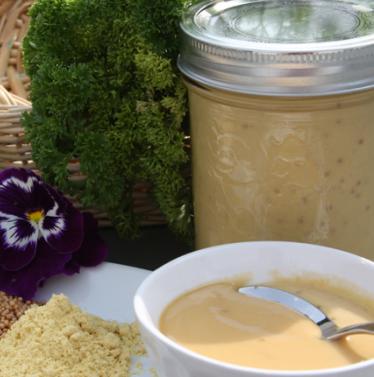 Axe
Axe
Roasted Garlic Paste
Use as a spread. Use to add rich flavor to soups, vegetable dips, or basted on meats.
1 pound whole garlic heads
1/2 cup olive oil
Salt and freshly ground black pepper
Preheat the oven to 350 degrees F.
Peel the outermost layers of skin off the heads of garlic. Cut off the top 1/3 of the heads to open the cloves. Put the heads, cut sides up, in a small baking dish and pour the olive oil over them. Season with salt and pepper. Cover tightly, place in the oven, and roast until about 3/4 cooked, about 45 minutes. Uncover and return to the oven until the cloves begin to pop out of their skins and brown, about 15 minutes. Let cool.
When garlic is cool enough to handle easily, squeeze the roasted garlic into a small bowl. Press against the skins very well to get out all the sweet roasted garlic you can. Add the oil from the baking dish and mix well until a paste forms. Store, tightly covered, in the refrigerator, for up to 1 week. Yield: about 1 cup.
Source: Easy Entertaining with Michael Chiarello. Episode: Skewer This
From:
FoodNetwork.com
To Print or Pin the Recipe, or to Post and/or Read
Comments

Plum Sauce (Tkemali)
Grilled meats and fish are rarely served plain, since they make such excellent foils for sauce. Georgian sauces offer tremendous variety. Most are prepared from the same fruits, vegetables, and nuts that appear in various guises in other dishes. Plums, blackerries, blackthorn, grapes, pomegranates, tomatoes, and cornelian cherries are all puréed for sauce, as are cilantro, beets, garlic, and spinach. Georgian sauces are characteristically tart; some are piquant as well. An interesting feature of the Georgian sauce repertoire is that the same basic dressing adorns vastly different foods. Thus the nut sauce satsivi is served with meat, poultry, fish, and vegetables alike. Some sauces are so delicious in and of themselves that a common expression goes, "With a Georgian sauce you can swallow nails!"
Tkemali is the universal condiment in Georgia, used much as Americans use ketchup. It is prepared from the small, tart tkemali plum for immediate enjoyment or longterm keeping. Tkemali is meant to provoke the palate. It enlivens chicken and vegetables--such as the famous lobio tkemali) kidney beans in red plum sauce--and is the classic accompaniment to grilled lamb or beef. Tkemali also lends a distinctive flavor to soups and stews.
To make tkemali in America, I recommend using Santa Rosa plums. The finished sauce takes on a luscious shade of pink.
1 1/2 pounds plums (not too sweet or ripe)
1/4 cup water
3/4 teaspoon whole coriander seed
1 teaspoon fennel seed
2 large garlic cloves, peeled and roughly chopped
1 teaspoon cayenne
1/2 teaspoon salt
1 tablespoon finely minced fresh mint
1/3 cup finely minced cilantro
Cut the plums in half and remove the pits. Place in a saucepan with the water and bring to a boil. Sinuner, covered, for 15 minutes, or until soft.
In a mortar with a pestle, pound together the coriander seed, fennel seed, garlic, cayenne, and salt to make a fine paste.
When the plums are soft, put them through a food mill and return to a clean pan. Bring to a boil and cook over medium heat, stirring for 3 minutes. Stir in the ground spices and continue cooking until the mixture thickens slightly, another 5 minutes or so. Stir in the mince mint and cilantro and remove from the heat. Pour into a jar while still hot. Either cool to room temperature and keep in the refrigerator, or seal the jar for longer storage.
From:
The Georgian Feast: The Vibrant Culture and Savory Food of the Republic of Georgia by Darra Goldstein.
To Print or Pin the Recipe, or to Post and/or Read
Comments
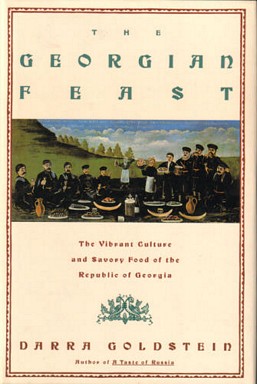
Georgian Pickled Plum Sauce (Tkemali) Recipe
1 pound plums, underipe, red
3/4 cup water
3 tablespoons lemon juice, fresh, or more to taste
1 tablespoon olive oil
3 cloves garlic, minced
1 1/2 teaspoon ground coriander
1/2 teaspoon salt
1/2 teaspoon red pepper flakes, hot, or more to taste
1/4 cup cilantro, minced fresh or dill
Fill a large saucepan half full of water and bring to a boil over medium-high heat. Immerse the plums in the water for 1 minute, then drain and rinse under cold running water. Slip off the skins, using a sharp paring knife. Cut each plum around its circumference all the way to the stone, then twist the halves in opposite directions to separate them. Use a spoon to pop out the stone. Cut each plum half in half again.
Combine the plums, water, 3 tablespoons lemon juice, the oil, garlic, coriander, 1/2 teaspoon salt, and 1/2 teaspoon hot pepper flakes in a small nonreactive saucepan and bring to a boil over medium heat. Reduce the heat to low and simmer, covered, until the plums are very soft, about 5 minutes.
Transfer the mixture to a food processor or blender and process to a smooth purée. Return the purée to the saucepan and stir in the cilantro. Bring to a boil over medium heat, then reduce the heat to medium-low and simmer until the sauce is reduced to about 2 cups, about 5 minutes.
Remove from the heat and taste for seasoning, adding salt, pepper flakes, or lemon juice as necessary; the sauce should be highly seasoned. Cool to room temperature and serve at once, or store, tightly covered in the refrigerator, for up to 2 weeks. Makes 2 cups.
Note: Prepare rhubarb as described above in step 2, substituting 1 pound fresh rhubarb, trimmed and diced, for the plums. You may need a tablespoon or so more sugar to balance the rhubarb's acidity.
From:
CDKitchen.com
To Print or Pin the Recipe, or to Post and/or Read
Comments

Sauce for Stir-fry
coconut milk
lots of garlic
lots of ginger
lemongrass
coriander
chilis
squeeze of lemon or lime juice (plus a bit of grated zest if you like)
I'm afraid I can't give you measures for any of these, as I just chuck them all in - you can't have too much garlic + ginger, you can have too much chilli.
From: Dominic Glennon on Yeast-L list
To Print or Pin the Recipe, or to Post and/or Read
Comments
Gravies
Sausage Gravy
16 oz. bison breakfast sausage
2 tablespoons arrowroot powder
14 oz coconut milk
1/4 teaspoon fennel seeds
1 tsp dried, rubbed sage
1/4 teaspoon cayenne pepper
1/2 teaspoon pepper
1/4 teaspoon salt
Heat up a skillet over medium-high heat and brown the sausage. Break up the sausage into fairly small pieces so it will cook easily, but I like to leave some bigger chunks in there too. Once the sausage is thoroughly cooked, remove it with a slotted spoon and set it aside. Discard most of the fat, but leave about a tablespoon in there, and leave all the stuck-on brown bits of sausage in the bottom of the pan.
Turn the heat down to medium. Add the arrowroot and stir it into the fat and brown bits, whisking constantly for about a minute so it doesn't burn. It will get pretty thick and almost dry.
Add the coconut milk about 1/3 at a time, and whisk together with the "roux," incorporating it thoroughly. Some of the browned bits should start to come off the bottom of the pan, too. This is what we want. Keep adding in the coconut milk until it is all incorporated. Add the fennel, sage, cayenne, salt and pepper and mix it in.
Add the sausage back in and incorporate throughout the gravy. Cook for a moment so everything is heated evenly.
Serve immediately over
Coconut Almond Biscuits.
Comments:
Arrowroot gravies need to be made immediately before serving. They will turn gummy if left to sit for too long. When it cools it develops an unusually slippery feel.
Arrowroot starch needs to be mixed with a few Tbs. cold water before adding to a hot liquid.
Recipe submitted by Amber, Norfolk, VA
From:
Tropical Traditions: Free Coconut Recipes [archive.org]
To Print or Pin the Recipe, or to Post and/or Read
Comments
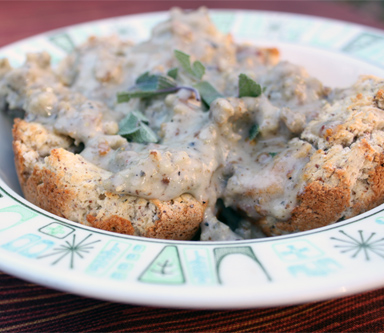 Amber, Norfolk, VA
Amber, Norfolk, VA
Porcini Mushroom Gravy
drippings from turkey
2 C mushroom stock (stewed mushrooms in vegetable or chicken stock)
1 T dried porcini mushrooms
1/4 C arrowroot powder
Soak porcini mushrooms in stock for 10 minutes (you can do this before the turkey is done), then blend on high until smooth. Combine stock and drippings in a saucepan over medium heat and reduce to taste. If the drippings have lumpy bits in them you can blend it as well.
In a small glass, add enough cold water to the arrowroot powder to make a thin liquid (1/4 C or less). While stirring constantly, add arrowroot to the gravy to desired thickness.
By Bruce Sherrod. Posted to the PaleoRecipe Mailing List, Dec. 2000
To Print or Pin the Recipe, or to Post and/or Read
Comments

Meat Gravy
1 cup meat drippings or broth
1 cup nutmilk
1 T plus 1 t arrowroot
Add arrowroot to nutmilk and stir well. Add to dripping and cook on low stirring constantly until gravy is thickened.
From: Patti Vincent
To Print or Pin the Recipe, or to Post and/or Read
Comments

Coconut Flour Gravy
3 tablespoons coconut oil
5 tablespoons coconut flour
1 1/4 cups water, beef or chicken broth
1 teaspoon salt
1 teaspoon sesame oil - optional
Heat coconut oil over medium heat until it begins to slightly boil. Add coconut flour all at once and stir constantly until dark brown - be careful not to burn it. Add water or broth all at once and bring to a boil using a whisk to combine the mixture into a smooth consistency. Cook at a low boil until desired consistency. Add salt and sesame oil and stir until oil is well mixed. Use your imagination for other seasonings.
If reheating leftover gravy, you may need to add more liquid.
Recipe submitted by Tammy, Cape Girardeau, MO
Comment by Carrie: I added oregano and thyme and it had a good flavor. I was not completely happy with the texture though. I could really feel the flour.
From:
Tropical Traditions: Free Coconut Recipes [archive.org]
To Print or Pin the Recipe, or to Post and/or Read
Comments
Thickening Tips
Thickening Sauces, Stews etc.
1. Arrowroot. I don't use this. I could, I suppose, just that it's very carb high. [Richard Geller]
Using arrowroot shouldn't be a problem in moderation and small amounts. I myself wouldn't use it on a regular bases though for the same reason you don't use it. [Patti Vincent]
2. Nuts. Ground up, they were used in the middle ages to thicken sauces. Get out those middle age cookbooks. I tried making a pesto from pine nuts, roasted garlic and cilantro, but it didn't really thicken a broth very well (perhaps need more pine nuts?) [Richard Geller]
I would think nuts would make sauces a bit grainy but I've never tried to use pine nuts myself. Maybe sauces made with nuts would just need to be cooked down for longer periods of time to thicken. Just a guess. I used to use carrots grated very fine in tomato sauces to help the thickening process. Depending on the sauce I suppose other vegetables could be steamed, mashed or riced and added to sauces for thickening.... Broccoli, cauliflower, brussel sprouts etc. [Patti Vincent]
3. Here's an interesting one: squash. I thickened a chicken curry with squash and it worked great. [Richard Geller]
4. Gelatine, demi glace, etc. make stock and reduce it, it will thicken and have great flavor [Richard Geller]
5. Tomatoes, ground up. I am not eating tomatoes much these days as I think they cause me problems. I used to use them quite a bit to thicken things. [Richard Geller]
6. Kuzu root starch is used in macrobiotic cooking. It is a superior quality thickener. I do not know if kuzu root is edible raw but I do know that it is gluten free. I use this together with gelatin to make a delicious gravy, which is totally lump-free and not at all starchy tasting. [Stacie Tolen]
7. Coconut milk is a great thickener for shakes, smoothies, etc. and also for curry. Pumpkin curry is a thick and hearty fall/winter supper. [Stacie Tolen]
8. I discovered WAY back, when trying to get people to eat vegetables, that using a lot of onions, carrots, celery while cooking a roast or chicken, then blending the softened veggies together with the broth made a delicious thick gravy that anybody would eat. A Vitamix works great for this. I guess you could try the same method with sweet things as well - fiber-rich fruits, with juices. [Holly Krahe]
9. Besides kuzu and arrowroot, I go to the Oriental grocery and purchase dried powdered white yam flour and sometimes dried acorn flour. They are neutral in flavor. For a sweet flavor, you can use chestnut flour. Mix them off heat in cold water to make a paste, and then slowly stir them into your sauce, soup, etc. I don't worry about the carb content, because a little goes a long way, especially when it becomes lost in a large pot of soup. Also, I'm sure aboriginals used ground acorns, chestnuts and tubers to make porridges, so in my kitchen, they are paleo. [Judy Genova]
To Print or Pin the Recipe, or to Post and/or Read
Comments

Speaking of Gravy
Speaking of gravy, I've made gravy using kuzu root or arrowroot instead of cornstarch or flour, in a mix of pan drippings and broth. These gravies need to be made immediately before serving, as they will turn gummy if left to sit for too long. Arrow and kuzu root starch needs to be mixed with a few Tbs. cold water before adding to a hot liquid.
By Stacie Tolen. Posted to the PaleoRecipe Mailing List, Nov. 2001
To Print or Pin the Recipe, or to Post and/or Read
Comments

Arrowroot Comments
Flavour and Colour: Snow white. Flavourless.
Breading: Browns quickly and well. Produces golden crispy coating.
Thickening: Excellent. Substitute for equal amount of cornstarch. Leftovers may need to be rethickened.
Baking: Substitute for 25-50% total flour. Will lighten baked goods.
Comments: Silky powder, much like cornstarch. Store tightly in sealed jar and refrigerate.
From:
The Allergy Self-Help Cook Book by Marjorie Hurt Jones R.N.
To Print or Pin the Recipe, or to Post and/or Read
Comments

Arrowroot Comments from "Minimax Cookbook"
In his book "Minimax Cookbook", Kerr says that both arrowroot and cornstarch are pure starches. He prefers them to flour for thickening liquids.
He recommends arrowroot for dark hot sauces because of its clarity and its lack of taste that might mask the food flavor. Arrowroot is good, too, he says, for giving pasta a glaze when he wants the pasta to have the look of oil on it.
Arrowroot, however, has a drawback in that when it cools, especially in contact with dairy foods, it develops an unusually slippery feel.
Another difference, according to Kerr, is that cornstarch requires thirty seconds at the boil to remove its starchy taste, while arrowroot clears in very hot liquid without the need to boil it.
Posted by Len S (elm at delphi.com) to rec.food.cooking on 27 Nov 1995.
To Print or Pin the Recipe, or to Post and/or Read
Comments

Re: arrowroot, what is it?
While the purposes are the same, there are some differences between the the finished product when using arrowroot v cornstarch.
Arrowroot slurries and cornstarch slurries are both used to thicken sauces and gravies. They both yield a clear, glossy sauce which gives a "mouth feel" and appearance similar to a sauce containing quantities of butter.
They both require much less time than a flour-thickened sauce. They are both used as slurries, stirred into the hot liquid *off heat!*. The arrowroot slurry is merely stirred into the liquid for 30 seconds to a minute and it's ready.
____
Arrowroot thickened sauces, on the other hand, freeze well in such preparations as chicken pies, and do not re-hydrolize (the word just popped out of my sub-conscious) when the pies are reheated. I have also used it for thickening chicken ala king, which I have then frozen and re-heated without any problems.
Posted by Edward Conroy to rec.food.cooking on 24 Jun 1996.
To Print or Pin the Recipe, or to Post and/or Read
Comments


